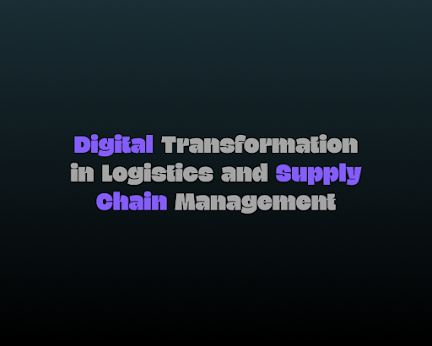Digital Transformation in Logistics and Supply Chain Management
Big data technology’s gradual emergence and the ongoing development of several work process technologies have given rise to new aspects. The emergence of the Internet of Things and other connected devices has profoundly affected the strategic functioning of the supply chain management technology. Finance, procurement, and warehousing are just a few of the areas of supply chain operations where it has sparked the expansion of digital transformation.
The idea behind digital transformation is examined in this article along with its effects on material handling procedures. Learn all about logistics company digital transformation in this post.
Important Factors Driving Digital Transformation In Logistics And Supply Chain Management
The digital revolution of supply chain management and logistics is being fueled by a number of causes, including:
⦁ Client Expectations
Consumers now want quicker, more convenient, and transparent product delivery. The sector is under pressure to change as a result of the high expectations that e-commerce behemoths like Amazon have set for quick and dependable delivery.
⦁ Technological Progress
The emergence of technologies like the Internet of Things (IoT), artificial intelligence (AI), blockchain, and sophisticated analytics has created new opportunities for streamlining and data-driven supply chain operations.
⦁ Data Accessibility
The abundance of data sources and the capacity to gather and analyze massive amounts of data have given important insights into the efficiency and weaknesses of the supply chain.
⦁ Globalization
Real-time visibility and cross-border cooperation have become essential as supply chains grow more global.
⦁ Regulatory Adjustments
Better monitoring and reporting capabilities are required as a result of tightening regulatory requirements for safety, sustainability, and traceability.
The Advantages Of Digital Transformation In Supply Chain And Logistics Management
Businesses may gain a lot from using digital technology in logistics and supply chain management, including the following:
⦁ Greater Visibility
Better supply chain visibility is made possible by shipments, inventories, and equipment being tracked and monitored in real time. This makes it easier to see bottlenecks, anticipate delays, and make wise choices.
⦁ Increased Effectiveness
Routine job automation, preventive maintenance, and optimal route planning save operating costs and boost productivity. Additionally, it reduces data input mistakes and human error.
⦁ Cost-Saving Measures
Digital transformation may result in considerable cost savings by simplifying processes,
cutting waste, and optimizing routes.
⦁ Improved Client Experience
Customer satisfaction and loyalty are better as a result of quicker delivery times, precise order tracking, and enhanced communication.
Inventory Management: Data-driven insights aid in more effective inventory management, which lowers carrying costs while maintaining product availability.
Sustainability: Through route optimization, fuel efficiency improvements, and waste reduction initiatives, digital transformation offers improved control of environmental consequences.
⦁ Risk Administration
Supply chain risks, including interruptions in the case of natural catastrophes or geopolitical concerns, may be identified and mitigated with the use of advanced analytics and predictive modelling.
Implementing Digital Transformation Faces Challenges
Although there is no denying the advantages of digital transformation, there are obstacles to overcome when applying it in logistics and supply chain management:
⦁ Implementation Fees
Digital technology implementation may be expensive up front, which may put off some businesses, tiny and medium-sized ones (SMEs).
⦁ Integration Difficulty
There may be compatibility problems as a result of legacy systems and procedures needing to be easier to combine with new digital solutions.
⦁ Data Privacy And Security
Concerns regarding data security and privacy are increasingly important as we rely more heavily on data. Strong cybersecurity measures must be in place for organizations.
⦁ Ability Gap
There won’t be enough qualified people managing and using digital technology in logistics and supply chain management.
⦁ Managing Change
Employees who are used to conventional working practices may reject changes made to established procedures and workflows.
⦁ Regulatory Conformity
It might be challenging to navigate the complicated and constantly changing requirements connected to data management and international logistics.
⦁ Choosing A Vendor
The success of digital transformation programs depends on selecting the best technology partners and providers.
Digital Technologies Transforming Supply Chain Management And Logistics
Let’s examine some of the essential digital technologies driving this progress in order to comprehend the scale of digital transformation in logistics and supply chain management:
⦁ Internet Of Things (IoT):
Assets like trucks, containers, and merchandise are tracked using IoT sensors and devices to keep tabs on their position, state, and performance. Predictive maintenance and improved decision-making are made possible by this real-time data.
⦁ Machine Learning And AI
To improve routing, demand forecasting, and inventory management, artificial intelligence (AI) algorithms and machine learning models examine massive amounts of information.
Virtual assistants and chatbots enhance customer care and assistance.
⦁ Blockchain
The origin and movement of items may be tracked using a transparent, unchangeable record that is made possible by blockchain technology. It improves traceability and lowers the danger of supply chain fraud.
⦁ Analytics For Big Data
Large amounts of data are processed and analyzed by advanced analytics technologies to provide insights into supply chain performance, consumer behavior, and market trends.
⦁ RPA: Robotic Process Automation
Data input and document processing are two repetitive operations that RPA automates, decreasing mistakes and freeing up human resources for higher-value jobs.
⦁ Forecasting Analytics
Predictive models estimate demand, manage inventory levels, and proactively handle supply chain interruptions using historical and real-time data.
Real-World Case Studies On Digital Transformation
Let’s look at a few real-world case studies to demonstrate the influence of digital transformation in logistics and supply chain management:
The Orion System From UPS
One of the most prominent package delivery firms in the world, UPS, used the Orion system for on-road integrated optimization and navigation. Orion optimizes UPS drivers’ delivery routes using AI and machine learning. UPS has significantly cut fuel consumption and greenhouse gas emissions by lowering idle time; unwanted left turns, and distance. Additionally, the method improves customer service by offering more precise delivery windows.
TradeLens From Maersk
Global container shipping business Maersk and IBM worked together to develop TradeLens, a blockchain-based platform for international commerce. TradeLens offers complete supply chain visibility, which decreases paperwork, boosts transparency, and guards against fraud. The platform has been used by several shipping lines and logistical firms, improving the effectiveness of global commerce.
Outlook For The Future
Logistics and supply chain management are now undergoing a digital transition, and this process has a bright future. A number of trends and developments will shape the end of this sector.
⦁ The introduction of 5G networks would provide quicker and more dependable data transmission, allowing in-the-moment asset monitoring and management.
⦁ Edge computing enables data processing to take place nearer to the data source, lowering latency and facilitating quicker decision-making in IoT applications.
⦁ As autonomous trucks, drones, and delivery robots are developed, last-mile delivery efficiency will be significantly improved.
⦁ As businesses embrace more environmentally friendly logistical techniques and technology to lower their carbon footprints, the emphasis on sustainability will only intensify.
⦁ Building resilient supply networks that can endure interruptions has been stressed as a result of the lessons learnt during the COVID-19 pandemic.
⦁ As e-commerce continues to expand, new logistics techniques must be developed in order to handle large numbers of online orders effectively.
⦁ By connecting all supply chain participants, from manufacturers and distributors to retailers and consumers, collaborative platforms and ecosystems will enable end-to-end visibility and coordination.
Conclusion
The logistics and supply chain management industries are undergoing a digital revolution, giving companies the chance to become more effective, customer-focused, and sustainable. Despite obstacles, businesses that use digital technology and adapt to shifting customer and market expectations will succeed in the dynamic world of logistics and supply chain management. The potential for innovation in this sector is almost endless as technology develops, and those who make sound investments in digital transformation will lead the way in its development.



Comments
Post a Comment